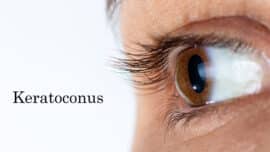Keratoconus is a progressive eye condition that causes the cornea, the clear front part of the eye, to thin and bulge into a cone-like shape. This irregular shape can significantly impair your vision, making it difficult to perform everyday tasks such as reading, driving, or even recognizing faces. Left untreated, keratoconus can continue to worsen, […]
Read More
Posted by Steven Greenstein on October 16, 2024
Introduction to EVO ICL Surgery EVO ICL is a type of refractive eye surgery that involves implanting a small, flexible lens inside the eye to correct nearsightedness (myopia) or astigmatism. Unlike the IOLs used in cataract surgery, which replace the eye’s natural lens, EVO lenses are placed in front of the natural lens, without removing […]
Read More
Posted by Steven Greenstein on October 9, 2024
What is a LASIK Enhancement? LASIK (Laser-Assisted In Situ Keratomileusis) is a laser eye surgery that can correct refractive errors like nearsightedness, farsightedness, and astigmatism. While LASIK is a safe and effective procedure that provides excellent, long-lasting vision improvement, some patients may experience changes in their vision over time that require additional treatment, known as […]
Read More
Posted by Steven Greenstein on October 8, 2024
Before receiving FDA approval in the U.S. in March 2022, the EVO ICL procedure had been widely available internationally for almost a decade. Today, we are proud to offer EVO ICL as a safe and effective option for vision correction. As leaders in the field, our expert refractive surgeons have undergone extensive training in the […]
Read More
Posted by Steven Greenstein on October 7, 2024
Cataracts are a common eye condition that affects millions of people worldwide. As we age, the natural lens in our eyes can become cloudy, leading to blurred or distorted vision. This condition, known as a cataract, can significantly impact your daily life, making it difficult to perform everyday tasks like reading, driving, or even recognizing […]
Read More
Posted by Steven Greenstein on October 3, 2024
Cataract surgery is a common and highly successful procedure performed to restore vision by removing the clouded natural lens and replacing it with an artificial intraocular lens (IOL). Traditionally, IOLs were designed with a fixed power, but advancements in technology have led to the development of a more customizable option, namely, the Light Adjustable Lens […]
Read More
Posted by Steven Greenstein on September 20, 2024
LASIK (Laser-Assisted In-Situ Keratomileusis) has become increasingly common among military personnel, as it offers a viable solution to reduce their reliance on corrective lenses and improve their overall visual acuity. LASIK works by reshaping the cornea, the clear front part of the eye, using an excimer laser. This process can effectively improve the eye’s ability […]
Read More
Posted by Steven Greenstein on September 19, 2024
Understanding Keratoconus: Causes, Symptoms, and Progression Keratoconus is a progressive eye condition that causes the cornea, the clear front part of the eye, to thin and bulge into a cone-like shape. This irregular shape can significantly impact your vision, making it difficult to see clearly. The exact causes of keratoconus are not fully understood, but […]
Read More
Posted by Steven Greenstein on September 16, 2024
Understanding Keratoconus: Causes and Symptoms Keratoconus is a progressive eye condition that causes the cornea, the clear front part of the eye, to thin and bulge into a cone-like shape. This irregular shape can significantly affect your vision, making it difficult to perform everyday tasks. The exact causes of keratoconus are not fully understood, but […]
Read More
Posted by Steven Greenstein on September 13, 2024
Traditionally, patients with advanced keratoconus had very few options for treating corneal ectasia. In the early days, the only option they were offered was generally a full corneal transplant (penetrating keratoplasty). More recently, partial thickness corneal transplants (anterior lamellar keratoplasty (ALK, DALK)) came into play as a slightly less invasive procedure. Intrastromal corneal ring segments, […]
Read More
Posted by Steven Greenstein on September 11, 2024













